
 |
Tea Clipper |
 |
| from TeaAntiques.com | ||
| Edition Forty Two |
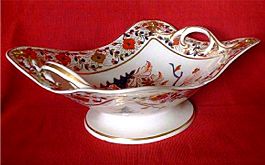 A very attractive and decorative Derby fruit stand of footed
rectangular shape with two foliate scroll handles, c1810. This wonderful early Derby fruit stand is in
excellent condition with bright and vibrant 'Imari' style decoration. It is
marked with the Derby pattern number 19. The
fruit stand is also marked on the base with the
A very attractive and decorative Derby fruit stand of footed
rectangular shape with two foliate scroll handles, c1810. This wonderful early Derby fruit stand is in
excellent condition with bright and vibrant 'Imari' style decoration. It is
marked with the Derby pattern number 19. The
fruit stand is also marked on the base with the
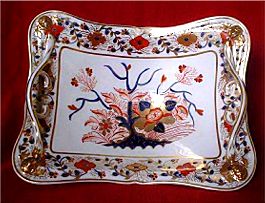 Derby red crown, baton and dot mark
used at the famous Derby factory c1800-1825.
Derby red crown, baton and dot mark
used at the famous Derby factory c1800-1825.
The shape of this fruit stand is of a deep rectangular shaped bowl standing upon an oval raised foot. There is a pair of naturalistic foliate scroll type handles, one at either end of the bowl. Also, a most delightful feature of this fruit stand are moulded lion head masks on each of the corners of the fruit stand's rim. These beautiful lion head masks are gilded and have a gilded moulded leaf on either side of the lion's head.
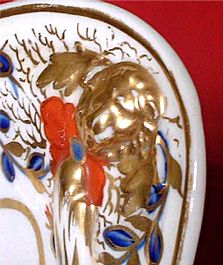
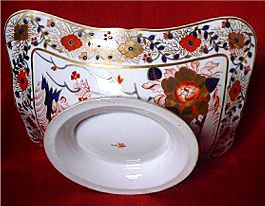
Other tea related antiques can be found by visiting my web site at www.TeaAntiques.com.
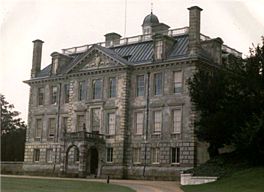
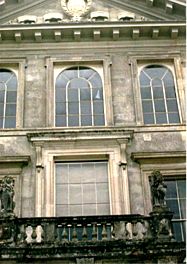 A
beautiful house in the hands of the National trust, Kingston Lacy is a house
that has undergone many changes and has inside a wonderful collection of fine
art and antiques.
A
beautiful house in the hands of the National trust, Kingston Lacy is a house
that has undergone many changes and has inside a wonderful collection of fine
art and antiques.
Kingston Lacy was the ancestral home of the Banks family for over 300 years. The house built by Sir Ralph Banks originates from the 17th century, but major alterations were commissioned in the nineteenth century undertaken by architect Sir Charles Barry. Approached through open parkland, the house with its large sash windows and Lantern tower on the roof looks quite imposing.
The first view of the house is of the north front. Originally it was built of red brick with Portland stone quoins (corner stone decorations). However as part of Sir Charles Barry's remodelling in 1835-40, the then owner William banks had the house encased entirely in Chilmark stone. It is this stone-encased house that we see before us today. A new entrance was formed at this time on this north front, as previously the entrance was to the east.
It was William Banks who was a great collector and filled the house with many of its treasures, collected from his time spent in Spain, Italy and Egypt. There is a fine collection of Egyptian artefacts in the house as well as an Egyptian obelisk from the Island of Philae, dating from 150 BC and a sarcophagus in the grounds.
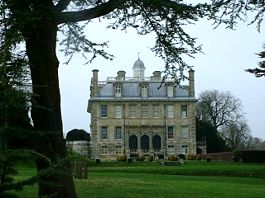 The East front has large arched windows
where once there was the main entrance to the house, these windows housing a
very grand marble main staircase to the house which led visitors up to the
principle rooms on the piano noble. Large cedar trees now frame this
aspect of the house.
The East front has large arched windows
where once there was the main entrance to the house, these windows housing a
very grand marble main staircase to the house which led visitors up to the
principle rooms on the piano noble. Large cedar trees now frame this
aspect of the house.
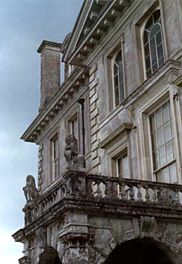 Entering
through the main doorway in the north front, the visitor is led into a marble
lined Hall from which a turn to the left takes you to the wide Carrara marble
staircase leading to the piano noble. Before ascending the stairs there
is a very comfortable and informal room to the left. This has symbols of every
day living from a time just past, with an old fashioned radiogram, television
and telephones. There is a bureau, bookcases and was obviously a much used room
towards the end of the house's occupancy.
Entering
through the main doorway in the north front, the visitor is led into a marble
lined Hall from which a turn to the left takes you to the wide Carrara marble
staircase leading to the piano noble. Before ascending the stairs there
is a very comfortable and informal room to the left. This has symbols of every
day living from a time just past, with an old fashioned radiogram, television
and telephones. There is a bureau, bookcases and was obviously a much used room
towards the end of the house's occupancy.
As
you make your way up the stairs there is the glazed loggia on a half landing,
from where there is a very good view of the small formal
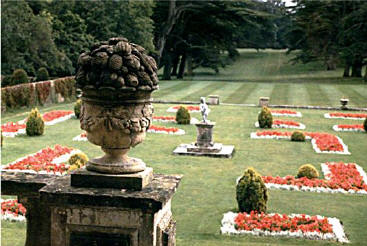 'Dutch' garden laid out
to the East of the house. This garden was laid out at the beginning of the
twentieth century. Charles Barry did have some more extravagant plans for this
side of the house, including raised walkways, glass conservatories and
fountains, but these were never built. He did plant several large Cedar trees in
1835 to provide a green approach to 'Pamphill' village beyond, these cedars, now
mature provide a majestic frame to the East elevation of the house from the
grounds.
'Dutch' garden laid out
to the East of the house. This garden was laid out at the beginning of the
twentieth century. Charles Barry did have some more extravagant plans for this
side of the house, including raised walkways, glass conservatories and
fountains, but these were never built. He did plant several large Cedar trees in
1835 to provide a green approach to 'Pamphill' village beyond, these cedars, now
mature provide a majestic frame to the East elevation of the house from the
grounds.
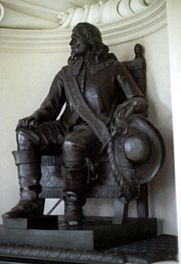
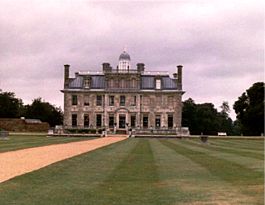 The
loggia houses some rather large bronze urns and statues including a massive one
of King Charles I commissioned by William Banks from Baron Marochetti.
The
loggia houses some rather large bronze urns and statues including a massive one
of King Charles I commissioned by William Banks from Baron Marochetti.
A second flight of marble stairs leads to the piano noble where there are the principle rooms of the house. Turning to the left is the Library, the first of the main rooms on the South front of the house. This room was initially two rooms, namely a withdrawing room and a closet. In the late eighteenth century it was remodelled into this library. Henry Banks was on the 'grand tour' between 1778-80 where he had a painting of him done by the famous Batoni, this was at his mother's insistence! This painting, which Henry Banks did not like and thought of little merit, now hangs in this Library on the window wall. Henry Banks died in 1834 and the Library is almost as it was at this time. His son William did add some more books and folios including the Description de l'Egypt (1809-28). There are many beautiful leather bound books within the built-in bookcases of this room - a feast of knowledge to be had for the reading.
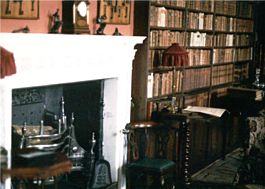
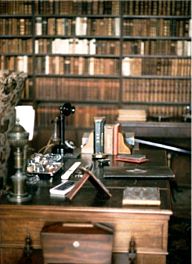
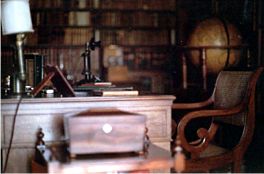
It is interesting to see above the fireplace the keys to Corfe Castle, now no more than a ruin following a siege, but which was once home to the Banks family ancestors. A pedestal desk sits in the room with a Regency scroll armed chair. There are the trappings of 'modern day' living in the shape of a black stick phone and electric table lamps. I also spotted a Regency Rosewood sarcophagus tea caddy c1820 on a wot-knot to one side of the desk.
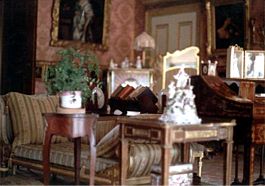
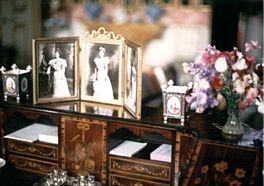
Leaving the Library, the next room in the centre of the South front is the delightful Drawing Room. This room was initially the Great Parlour of the 1660's house, but now is much more like an Edwardian cosy Ladies' Drawing Room with its delicate furnishings and feminine feel. The room was actually remodelled in the 1830's when Charles Barry raised the ceiling and had it reinstated with designs similar to those of Inigo Jones, sadly this ceiling was destroyed by fire in 1910.
At the South end of the room is a charming Carlton House desk with exquisite marquetry inlay. The inlay is very fine and includes flowers, garlands and ribbon bows. The room was really the creation of Henrietta Jane Fraser who married Walter Ralph Banks in 1897. They had two daughters and a son. She was however left widowed in 1904, but continued to run the estate on her own - her photograph stands upon the desk. She entertained Royal guests at the house and planned much of the garden design and planting. Her love of gardens and flowers is made evident by displays of flowers in the room including a simple posy of sweet peas on the desk.
It was Henrietta who had the walls of the Drawing Room hung with pretty pink damask and the sofa covered with green stripped silk fabric. It has certainly created a lovely room that has the rather delicately cluttered Edwardian look about it, but one of great comfort. The collection of nineteenth century French style saloon furniture is typical of the Edwardian style, as is the collection of Dresden porcelain on display. A teaset on a silver tray is displayed as a reminder that this room would have been a great favourite for the serving of tea to her guests.
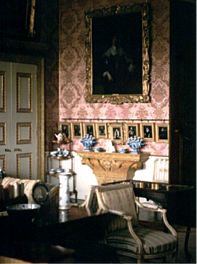 On
the far end walls are two large portraits by Van Dyck, these are of Sir John and
Lady Borlase (the eldest daughter of Sir John and Lady Banks). Below these great
paintings hang a set of 55 enamel miniatures painted on copper. These charming
little portraits were the work of Henry Bone (1755-1834) and portray Queen
Elizabeth I and her courtiers and other contemporaries.
On
the far end walls are two large portraits by Van Dyck, these are of Sir John and
Lady Borlase (the eldest daughter of Sir John and Lady Banks). Below these great
paintings hang a set of 55 enamel miniatures painted on copper. These charming
little portraits were the work of Henry Bone (1755-1834) and portray Queen
Elizabeth I and her courtiers and other contemporaries.
Next to the Drawing Room is the Dining Room, not an elegant room or even a comfortable looking room, it is rather austere. It does have an interesting huge circular dining table which is extendable by the additional of circular leaves to the circumference. Round the table are a set of William IV dining chairs - their seats unusually covered in giraffe hide.
A sideboard displays some of the family silver, including some large tureens.
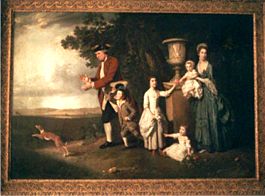 Leaving
the Dining room, the next room is altogether much more appealing, the Saloon is
in the centre of the North front and has double doors that open out to lead into
the Drawing Room that we were in earlier. This grand Saloon was the work of
architect Robert Furze Brettingham and was carried out in 1782. There is a
barrel vaulted ceiling from which hangs a beautiful crystal glass chandelier.
The walls are hung round with some very fine paintings, including many of the
Banks family from as early as 1659, although the Saloon was originally designed
to house a set of Gobelains tapestries.
Leaving
the Dining room, the next room is altogether much more appealing, the Saloon is
in the centre of the North front and has double doors that open out to lead into
the Drawing Room that we were in earlier. This grand Saloon was the work of
architect Robert Furze Brettingham and was carried out in 1782. There is a
barrel vaulted ceiling from which hangs a beautiful crystal glass chandelier.
The walls are hung round with some very fine paintings, including many of the
Banks family from as early as 1659, although the Saloon was originally designed
to house a set of Gobelains tapestries.
Finally, there is a room known as the Spanish Room as its walls are hung with Spanish leather. This a suitable background on which William banks could display his collection of Spanish paintings, a room known to him as the 'Spanish Picture Room'.
There is a magnificent ceiling in this room which was adapted from a Venetian ceiling that he bought in London in 1838. It has geometric panels of rich deep mouldings with inset painting and motifs.
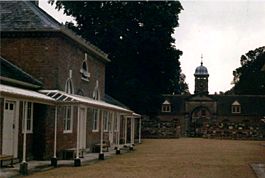 On
the next two floors above are the bedrooms of the household, including the State
Bedroom. But returning then to the ground floor, there is an exhibition of
Egyptian artefacts collected by Banks displayed in a room behind the servants'
Hall. Then leaving the house on the West side door, it leads into a courtyard
where there are outbuildings containing the
On
the next two floors above are the bedrooms of the household, including the State
Bedroom. But returning then to the ground floor, there is an exhibition of
Egyptian artefacts collected by Banks displayed in a room behind the servants'
Hall. Then leaving the house on the West side door, it leads into a courtyard
where there are outbuildings containing the
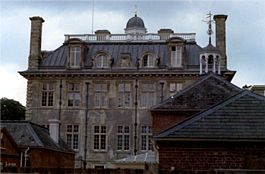 Laundry and Wash rooms on the left
and to the right what was the original old kitchen now houses the National
Trust shop.
Laundry and Wash rooms on the left
and to the right what was the original old kitchen now houses the National
Trust shop.
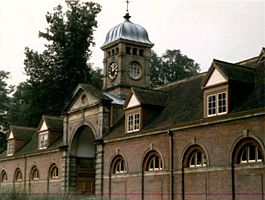 There
is a restaurant in the old stable yard that has some good food and tea available
to refresh the visitor, maybe before a wander round the grounds of this
impressive house.
There
is a restaurant in the old stable yard that has some good food and tea available
to refresh the visitor, maybe before a wander round the grounds of this
impressive house.
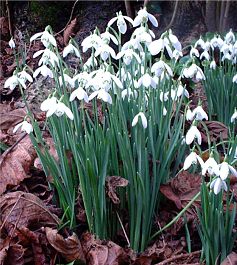 I hope that you have enjoyed my tour of the house and I will
be returning to the house again next January to visit the grounds when the
pretty white snowdrops are out in bloom providing some winter cheer and evoking
thoughts of Spring once more.
I hope that you have enjoyed my tour of the house and I will
be returning to the house again next January to visit the grounds when the
pretty white snowdrops are out in bloom providing some winter cheer and evoking
thoughts of Spring once more.
Kingston Lacy
Wimborne Minster
Dorset
BH21 4EA
Tel: 01202 883402
Fax: 01202 882402
Website:
http://www.nationaltrust.org.uk
Click here for
Local Map
Map courtesy of www.streetmap.co.uk
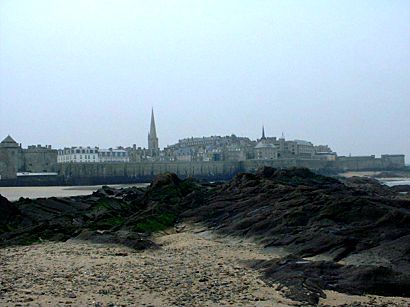 During
a damp and cold March this year, I was able to take a trip across the English channel to St Malo
on the coast of Brittany. I always enjoy sampling the local foods and cafés when
I am on a trip. So as part of the trip, I
was on the look out for a good French café and I was very pleasantly rewarded by
the discovery of a delightful one in St Malo called 'Timothy'.
During
a damp and cold March this year, I was able to take a trip across the English channel to St Malo
on the coast of Brittany. I always enjoy sampling the local foods and cafés when
I am on a trip. So as part of the trip, I
was on the look out for a good French café and I was very pleasantly rewarded by
the discovery of a delightful one in St Malo called 'Timothy'.
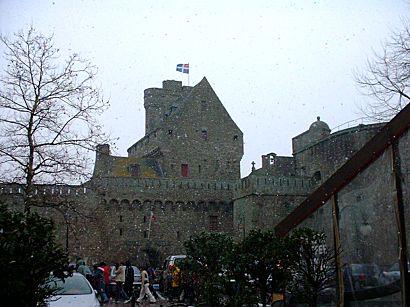
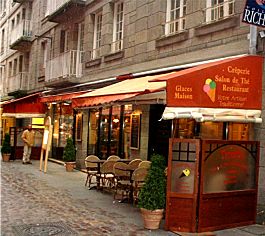 I
had not really expected to find a good place to enjoy tea in St Malo, as I
believe the French are more coffee drinkers than tea drinkers, but how wrong I
could be? I can say that not only did Timothy's serve tea, they did it with
perfect style. Their choice of local and regional French cuisine, as well as
fine French tarts and sweets were listed together with a traditional 'English'
cream tea.
I
had not really expected to find a good place to enjoy tea in St Malo, as I
believe the French are more coffee drinkers than tea drinkers, but how wrong I
could be? I can say that not only did Timothy's serve tea, they did it with
perfect style. Their choice of local and regional French cuisine, as well as
fine French tarts and sweets were listed together with a traditional 'English'
cream tea.
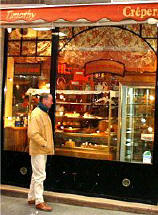 I
was drawn into this delightful café, firstly by the sumptuous cakes displayed in
their window and also the intriguing compendium of red tea canisters on shelves
behind their counter. It was an unseasonable day in that we had a heavy snow
shower (you can see the snow on the left-hand picture!) and it was bitterly cold, so what more welcoming inside than a real log
fire - this shop looked like heaven to me!
I
was drawn into this delightful café, firstly by the sumptuous cakes displayed in
their window and also the intriguing compendium of red tea canisters on shelves
behind their counter. It was an unseasonable day in that we had a heavy snow
shower (you can see the snow on the left-hand picture!) and it was bitterly cold, so what more welcoming inside than a real log
fire - this shop looked like heaven to me!
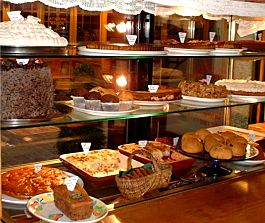
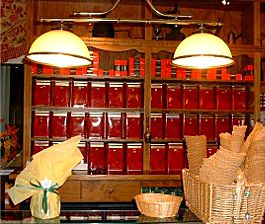

It was too much to try and choose just one thing from the menu, so I thought as well as seeing what their cream tea was like, I must try a local type of cake too. So, I ventured to try 'Far Breton', a local delicacy. As for the tea, I was quite stunned by the choice of fine teas and blends of tea on offer and decided upon Keemun.
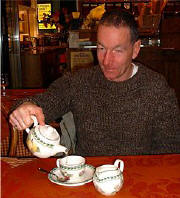 Being
all too often used to being served tea with a tea bag dangling in a cup, both in
England and on the continent, I was again amazed to see the tea delivered in a
Being
all too often used to being served tea with a tea bag dangling in a cup, both in
England and on the continent, I was again amazed to see the tea delivered in a
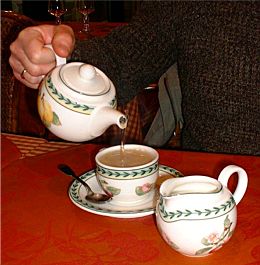 fine china pot, with matching jugs, cups and saucers.
fine china pot, with matching jugs, cups and saucers.
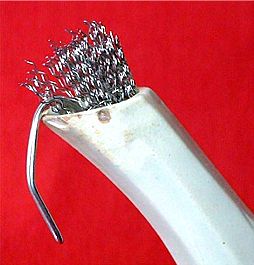 One
thing that I had never seen used before is a wire brush inserted into the teapot
spout to act as a strainer! It worked very well, although did slow the speed of
pouring the tea down a little.
One
thing that I had never seen used before is a wire brush inserted into the teapot
spout to act as a strainer! It worked very well, although did slow the speed of
pouring the tea down a little.
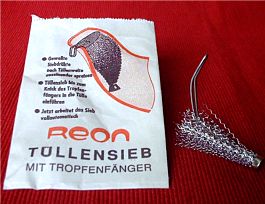 These ingenious little wire brushes were also
sold on the counter of the café and so I bought a couple to bring home and try.
These ingenious little wire brushes were also
sold on the counter of the café and so I bought a couple to bring home and try.
The cream tea arrived in style with a plate on which were the usual scones, preserve and cream. These scones were absolutely delicious, lightly fruited and with a rather yeasty bread type of texture. They were a bit different to English scones, but every bit as good.

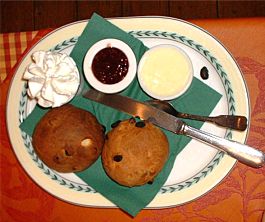
The Far Breton was good too. This dessert cake is based on a sort of pancake mixture that is baked in the oven and has within it prunes that have been soaked overnight in rum. After finishing this very tasty local treat, I was more than full and ready to continue my sight seeing of the beautiful walled town of St Malo.
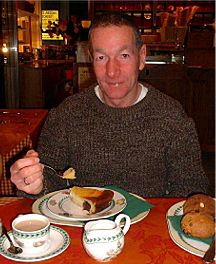
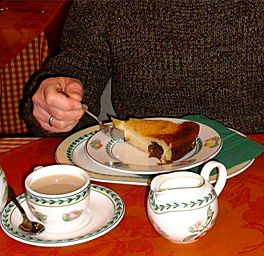
Upon my return to England, I made the French Far Breton, which turned out fine and with which I will serve to friends for tea - giving them a taste of France for a change.
Timothy's is certainly one up for the French - my congratulations.
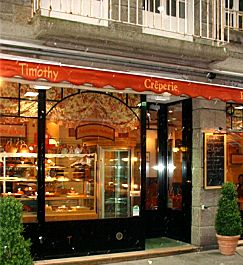
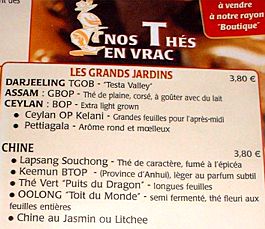
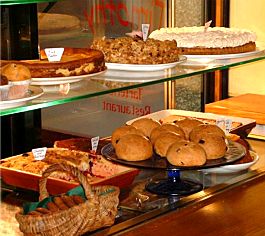
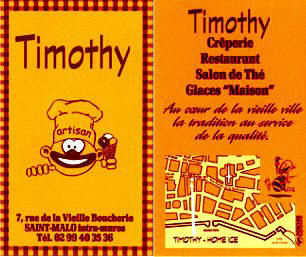
Click here for
Local Map
Map courtesy of www.multimap.com
To review past newsletters, just follow this link:
Past newsletters.
To subscribe to this free newsletter -
Click here